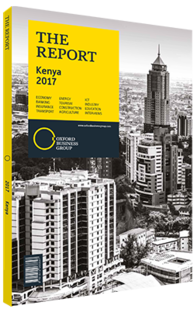A growing population and urbanisation feeds Kenya's cement industry
The story of cement in Kenya in the last five years largely tracks that of the construction industry in general. As the government has announced a raft of infrastructure projects and the construction sector has experienced double-digit growth, so has the consumption of cement shot up. However, unlike many markets that are experiencing a construction boom, in Kenya there has been little pressure on building materials supply and the cost of construction has remained under control.
Indicators
Between 2010 and 2014 the consumption of cement increased by 68.4% to 5.2m tonnes, according to the Kenya National Bureau of Statistics (KNBS). In 2014 alone consumption was up by 21.8%, while credit to the cement industry was up by 13.6% to KSh80.4bn ($784.5m).
This shows little sign of slowing down. In the two years to March 2016, consumption has increased by 33% or 1.4m tonnes. It is not hard to see what is driving this; Kenya’s construction industry grew at a rate of 13.6% in 2015, marking it out as one of the best performing sectors of the national economy. Indeed, all facets of the industry, from real estate to transport and energy infrastructure, have experienced heavy investment, and Kenya has the highest share of mega-infrastructure projects across the whole East African region.
Supply & Demand
Given this heavy demand for cement, it is perhaps surprising that there has been little price pressure on the material and, as such, few ramifications for the overall cost of construction. However, Kenya has a large and well-established cement industry and consequently supply has kept pace with the rapid increase in consumption. Cement production stood at 6.3m tonnes at the end of 2015, up from 5.8m tonnes a year earlier.
In the two years to the beginning of 2016, supply of cement in Kenya has increased by 25%. “Cement is already in overcapacity in the country, and increased cement coming on-line from new entrants and new factory expansions will exacerbate this,” Bruno Pescheux, country CEO of Bamburi Cement, a subsidiary of LafargeHolcim, told OBG.
More Output
Despite the excess supply in the market, production capacity in the country is set for further increases. Mombasa Cement, for example, announced plans in early 2016 to build 2 new cement plants at a cost of KSh7.3bn ($71.2m). This investment will triple the company’s capacity to 9000 tonnes per day.
The announcement comes at a time when other regional and global players are eyeing the Kenyan market. A new $131m plant developed by Cemtech, a subsidiary of India’s Sanghi Group, is expected to bring an additional 1.2m tonnes of cement to the domestic market upon completion. The commencement of construction on the greenfield project is slated for 2016. This follows plans by Nigeria’s largest cement producer, Dangote Cement, to establish operations in Kenya.
Given these developments, the material is likely to remain extremely price competitive in the short to medium term at least. Indeed, despite the rapid increase in demand in the local market in the last 5 years, the price of cement has softened considerably. In the first quarter of 2016 the average price of a 50-kg bag stood at KSh650 ($6.34). This was down from an average price of KSh700 ($6.83) for the same size bag in 2014. Indeed since 2009 the average price of a 50-kg bag has fallen by just over 13%. As one of the key basic materials in the market this is good news for developers and construction clients as they look to minimise costs. Kenya has traditionally been a relatively cheap place to build, and the competitive pricing of cement reinforces this. According to a 2014 study by Aecom, a US-based engineering firm, Nairobi, along with Accra, had the cheapest cost of construction for a major city in Africa. For example, low-cost housing in the Kenyan capital averaged $340 per sq metre, compared to $440 per sq metre in Abuja, $480 per sq metre in Kigali and $625 per sq metre in Luanda. The trend was similar when it comes to hotels, offices and retail outlets.
You have reached the limit of premium articles you can view for free.
Choose from the options below to purchase print or digital editions of our Reports. You can also purchase a website subscription giving you unlimited access to all of our Reports online for 12 months.
If you have already purchased this Report or have a website subscription, please login to continue.

